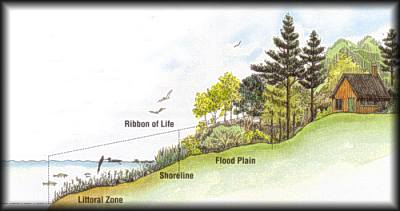LANDSCAPING WITH NATURE
The Ribbon of Life
The most important ecological region of a lake or river is the ribbon of life, the area near the shore. It is made up of two sections, a water section known as the littoral zone and a land section known as the flood plain.
The littoral zone is that part of the lake or river where sunlight can reach the bottom. As a general rule of thumb, it means the area containing rooted plants. The flood plain is that area which naturally stores excess water during floods. As much as 90 percent of living things in a lake or river are found within this ribbon of life. Disruptions to this zone have severe consequences on the ecological health of the whole region.

Naturally Beautiful
The old approach to cottaging was to go onto your property, park your cottage close to the water, clearcut the area in front of it (for the view), put in a lawn, bulldoze a nice big parking areas, put in a large, solid dock, and dump a bunch of sand along the shore to create an artificial beach. We now know that these types of practises have had severe detrimental impacts on the ecology of our lakes and rivers.
On the waterfront, the "natural look" is the one to have. It looks great, it fits in, it costs less and it helps to protect that precious water quality in the lake.
Most of the landscaping on your waterfront property was already done by the time you got there. Your lot is part of a well-connected ecosystem produced by ten thousand years of natural evolution. The features that attracted you to the lake in the first place -- the trees, the rocks, the thin soil, the ferns and flowers --- are part of a bigger natural system that supports the water quality of the lake, preserves fish and wildlife habitat, and, incidentally, increases the value and the natural beauty of the shore.
Most people want a modest view of the lake from their cottage. But clearcutting the natural vegetation is not necessary. Pruning shoreline vegetation for a view is an attractive alternative. You keep the shade and wind protection and add a nice view to the water. Avoid removing good wildlife trees and shrubs like oak, red osier dogwood, cedar and white pine. Cut just the branches in front of your line of sight and leave the rest.
More people are leaving the manicured lawn in the city and opting for the "meadow look". This means lower maintenance costs, no infernal combustion lawnmower engines on quiet Sunday mornings, and a lot more good old-fashioned "relaxing time".
Roads, driveways and powerlines can be placed to minimize impact on the landscape. Use existing clearings for building locations wherever possible. Keep buildings and septic systems at least 30 metres from the water's edge (a legal requirement in most municipalities).
Natural landscaping protects the environment and contributes to the appeal and value of your waterfront property.
Join the trend to naturally beautiful landscaping on the waterfront. Avoid using chemicals near the water. Resist tampering with or "cleaning up" your shoreline vegetation. Spend more time in the hammock this summer. If anybody gives you a hard time, just tell them you're doing your bit for the environment!
If your property borders the Rideau Canal Waterway and you plan to do any shoreline stabilization work, then view the
Parks Canada Guidelines for Shoreline Stabilization on the Rideau Canal.
If your property borders the Rideau Canal Waterway and you plan to do any removal of aquatic vegetation (aka "weeds"), then view the
Parks Canada Guidelines for Aquatic Vegetation Removal.
For some interesting fact sheets on how to landscape with nature have a look at the LandOwner Resource Centre extension note series on Preserving and Restoring Natural Shorelines and Restoring Shorelines with Willows.
Note: Drawings on this page taken from "On the Waterfront" published by the Rideau Valley Conservation Authority
|